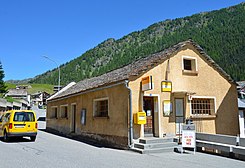Swiss Post
[15] In 1843, the cantonal post of Zürich issued the first stamp in Switzerland[16] so the postman was relieved of the duty of collecting the money from the clients.[17] In Canton Bern the Fischerpost was the official provider of postal services, and it also operated the line over the Gotthard Pass to Italy.[22] Lucerne expanded its own service to the south in the Ticino, and its messengers were given transit rights through the cantons of Schwyz and Uri.[27] The location of Basel at the northern border of Switzerland made the city a prominent centre for international mail exchange.[33] After four years of litigation before a court in Frankfurt, the Duke of Thurn und Taxis conceded the postal rights of Schaffhausen to Switzerland in return for 150,000 CHF in 1853.[38] At the beginning of the twentieth century, with technological progress, new significant means of communication arrived: the telephone and the telegraph.[41] Under Guido Nobel, Swiss Post introduced several innovations: in 1975, the first national mobile telephone network (Nationales Autotelefonnetz, from which the name Natel is derived) was established.[42] In 1978, the first Postomat (ATM) in the country was inaugurated,[43] and in 1982, barcodes were introduced for mail processing, along with the creation of a new logo for Swiss Post by the typographer Adrian Frutiger.[45] Also under Nobel, in the first half of 1986, the postal service began the national implementation of the ISDN internet network,[46] which was launched in 1988,[47] and in 1987, the videotex/teletext system was introduced.[50] Under the new legislation that came into effect between 2012 and 2013, PostFinance was spun off into a private limited company subject to the supervision of FINMA, while remaining entirely owned by Swiss Post.[60] Due to changing societal habits and the rise of digital activities, between 2000 and 2024 there has been a rationalization of services, reducing the number of postal offices from approximately 3,500 to around 700.[65][54] The wagons with 4 axles were equipped with compartments in which the mail was sorted[65] and by 1965, over sixty postal train lines had come into service.[67] Before the 1930s Swiss air mail reached Africa and Asia and by the 1930s seaplanes flying from the Atlantic ocean landed in South and North America.[67] From 1931 onwards, the newly founded Swissair facilitated the creation of a dense European network for airmail deliveries.


limited company (AG)Swiss PTTSwitzerlandGermanFrenchItalianRomanshpostal serviceSwiss ConfederationUniversal Postal UnionSt. GallenThurn und TaxisSchaffhausenHelvetic RepublicThurgauGotthard PassRapperswilsteamboatLake ZürichSolothurnFribourgGenevaTicinoSchwyzLake LucerneAltdorfCanton Glaruspost boxesStrasbourgSimplon, Valaisconstitutionfirst stampsFlüelenCamerlataFrankfurtDuke of Thurn und TaxistelephonetelegraphPostal Telegraph and TelephonePostal CodesUnited StatesGermanyGuido Nobelmobile telephonefiber opticNeuchâtelbarcodesPostFinanceinternetteletextSwisscomhorsesSwiss RailwaysseaplanesAtlantic oceanNorth AmericaSwissairWorld War IITrans World AirlinesZurichtavernsSt. Bernhard dogAdelbodenPTT ArchivePostal codes in Switzerland and LiechtensteinPostBus SwitzerlandAsendiaEisenbibliothekHistorical Dictionary of SwitzerlandFederal administration of SwitzerlandChancelleryForeign AffairsHome AffairsJustice and PoliceDefence, Civil Protection and SportFinanceEconomic Affairs, Education and ResearchEnvironment, Transport, Energy and CommunicationsSwiss Federal RailwaysSkyguidePolitics of SwitzerlandGovernmentParliamentCourtsCantonsPostal administrationsÅlandAlbaniaAndorraArmeniaAustriaAzerbaijanBelarusBelgiumBH PoštaHrvatska pošta MostarPošte SrpskeBulgariaCroatiaCyprusCzech RepublicDenmarkEstoniaFaroe IslandsFinlandFranceGeorgiaGibraltarGreeceGreenlandGuernseyHungaryIcelandIrelandIsle of ManJerseyKosovoLatviaLiechtensteinLithuaniaLuxembourgMoldovaMonacoMontenegroNetherlandsNorth Macedonia